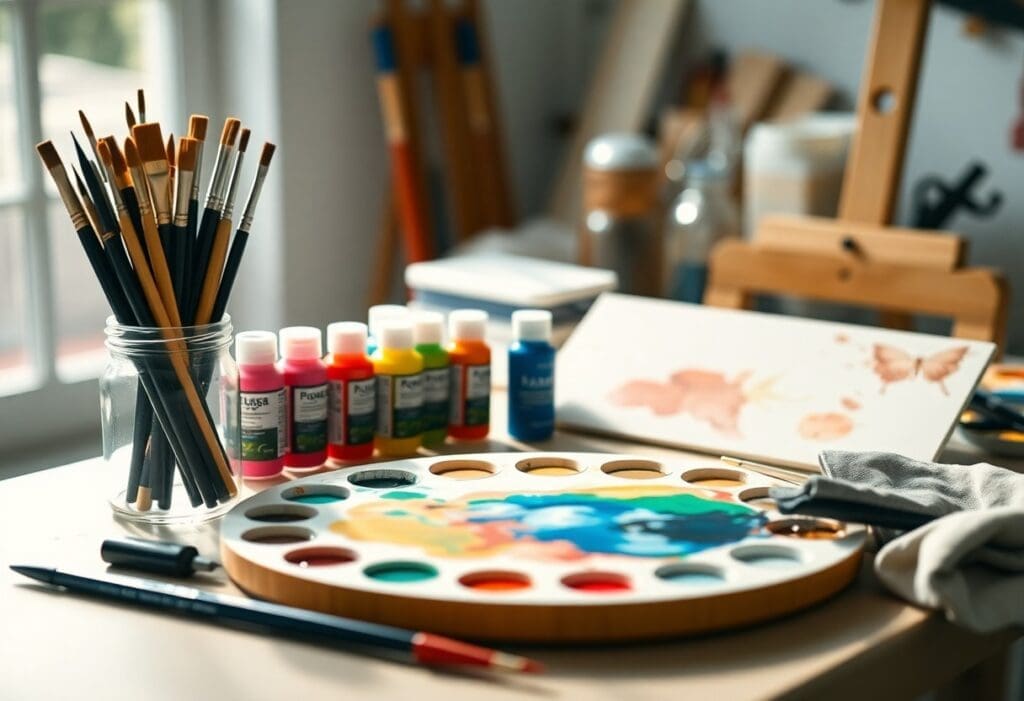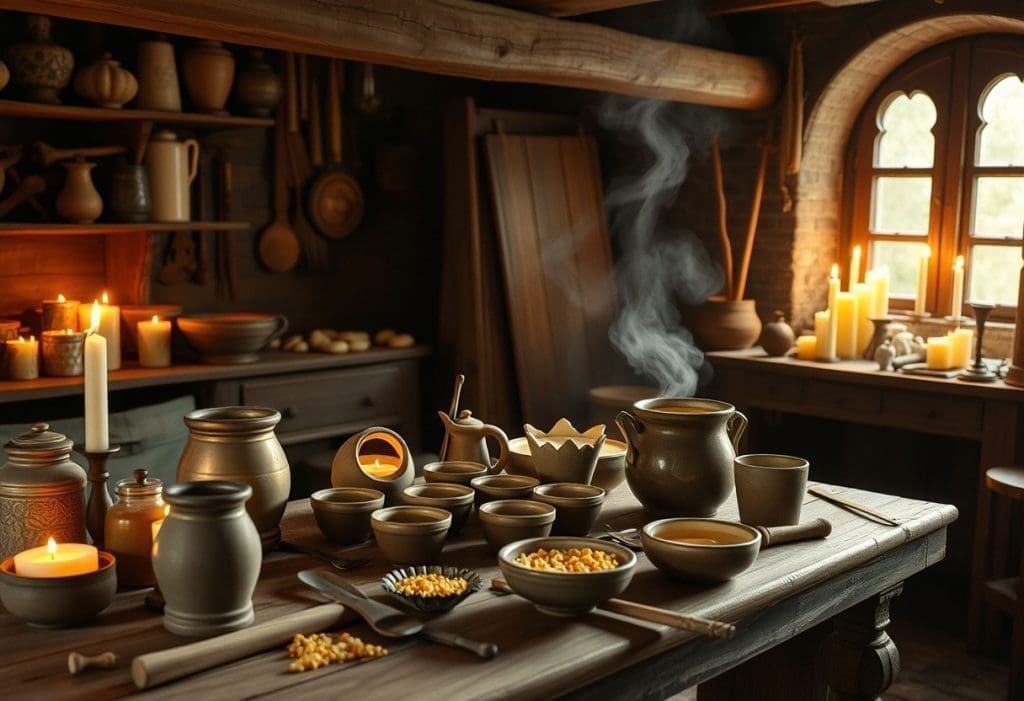As an artist, you invest a significant amount of time, effort, and money into your painting supplies.
To get the most out of your investment, be sure to clean and maintain them regularly.
You want to ensure that your brushes remain soft and supple, your paints stay vibrant, and your easels will last a long time.
By following a few simple steps, you can extend the life of your supplies, prevent damage, and maintain their quality.
In this post, we’ll guide you through the process of properly cleaning and maintaining your painting supplies.
Why Cleaning and Maintenance Are So Important
As with anything you invest in, you want to get the most bang for your hard earned buck, right?
Painting supplies are no different. When you take care of them, you’ll not only get better results when you use them.
You’ll also avoid wasting money on unnecessary replacements.
Why Proper Care Extends the Life of Your Tools
When you clean and maintain your supplies, you prevent the buildup of dried paint, dirt, and other debris that can cause damage and wear.
The Consequences of Neglecting Your Supplies
When you neglect your supplies, you may notice a decline in the quality of your work, as well as an increase in frustration and wasted time.
For instance, a dirty brush can leave streaks and marks on your canvas, while a clogged airbrush can cause uneven spray patterns.
By cleaning and maintaining your supplies, you can avoid these issues and focus on creating your best work.
Preparing Your Workspace for Cleaning and Maintenance
A cluttered and chaotic environment can lead to mistakes, damage, and wasted time.
Take a few minutes to clear a flat surface, such as a table or countertop, of any debris, dust, or unnecessary items.
This will provide a clean slate for you to work on and help you stay focused on the task at hand.
Gather Cleaning Materials and Tools
You’ll need a variety of materials, such as soft cloths, gentle cleaners, and precision tools, to tackle different tasks and surfaces.
Tools like paintbrush cleaners, palette knives, and cotton swabs will help you remove dried paint, scrape off stubborn residue, and reach into small crevices.
You’ll want to have a range of cleaning solutions on hand, from soap and water to specialized brush cleaners. These will ensure you’re prepared to tackle any mess or stain that comes your way.
Take stock of what you have and make a list of what you need to pick up before you begin the cleaning process.
How to Clean Your Paint Brushes
By cleaning your brushes, you will prevent paint from drying on the bristles, which can cause them to become brittle and break.
A well-maintained brush will continue to perform well, giving you the best results in your artwork.
Remove Excess Paint and Debris
After you’ve finished painting, gently wipe your brushes against a paper towel or cloth to remove any excess paint and debris.
This initial cleaning will make the next steps much easier and more effective.
Wash and Shape Your Brushes
Next up, it’s time to wash your brushes using mild soap and warm water.
Gently massage the soap into the bristles, working from the base of the brush to the tip. Rinse and shape your brushes back to their original form.
Excess soap can damage your brushes, so make sure to rinse them thoroughly. Use lukewarm water to prevent the glue from loosening, which can cause the bristles to fall out.
As you shape your brushes, use a gentle touch to avoid damaging the bristles or causing them to become misshapen.
Tips for Maintaining Your Paint Brushes
Here are some tips to help you maintain your paint brushes:
Store Brushes Properly to Prevent Damage
If you want to keep your paintbrushes in good condition, store them in a cool, dry place away from direct sunlight.
This will prevent the bristles from becoming brittle or discolored.
Regularly Inspect and Condition Your Brushes
You need to inspect your paint brushes on a regular basis by checking for loose bristles, cracks, or damage to the ferrule.
If all looks good, the next step is to condition them. Use a gentle brush cleaner or conditioner to remove dirt and oils that can accumulate on the bristles.
This will help restore their natural flexibility and prevent them from becoming stiff or brittle.
By doing so, you’ll be able to maintain the quality of your paint brushes and ensure they continue to perform well.
Cleaning and Maintaining Your Paints
All good painting practices start with clean and well-maintained paints.
By taking care of your paints, you can ensure they remain vibrant and usable for a long time.
Handling and Storing Paint Tubes and Jars
There’s a right way to handle and store your paint tubes and jars to prevent damage and contamination.
Always hold tubes by the cap and not the body, and store them upright to prevent paint from leaking out.
How to Prevent Paint from Drying Out and Separating
You never want your paints to dry out and separate. They’ll be useless if this happens.
Start by always tightly sealing tubes and jars, storing them in a cool, dry place, and using a palette with a lid (if you don’t have a lid, you can cover it with plastic wrap when not in use).
This is especially important for water-based paints, which are more prone to drying out.
By following these simple steps, you can extend the life of your paints and ensure they remain vibrant and usable for your next project.
Always check the expiration dates of your paints and replace them if necessary to maintain optimal performance.
Factors to Consider When Choosing Cleaning Products
Not all cleaning products are created equal. When it comes to cleaning your painting supplies, you’ll want to choose products that are gentle yet effective.
Consider the type of supplies you’re cleaning, the level of dirt or grime, and any specific needs or recommendations from the manufacturer.
Also take in to account your own personal preferences and sensitivities, as well as the environmental impact of the products you choose.
After all, the right cleaning products can make all the difference in keeping your supplies in top condition.
Select Gentle yet Effective Cleaning Agents
Mild cleaning agents are often the best choice for cleaning painting supplies. They won’t damage or strip away important coatings or finishes.
Look for products that are specifically designed for cleaning art supplies, and opt for those that are labeled as “gentle” or “non-toxic.”
These products will help you get the job done without putting your supplies OR your health at risk.
Avoid Harsh Chemicals that Can Damage Supplies
Be cautious when choosing cleaning products, and steer clear of those that contain strong acids, alkalines, or abrasives.
For instance, bleach and ammonia are both common household cleaners that can be too harsh for many art supplies.
Similarly, abrasive cleaners like scouring powders or rough sponges can scratch or wear away delicate surfaces.
By avoiding these types of products, you can help ensure that your painting supplies remain in good condition and continue to perform well over time.
How to Clean Your Palettes and Surfaces
Your painting palettes and surfaces require regular cleaning to prevent paint buildup and ensure they remain in good condition.
A clean palette and surface also help you achieve better color mixing and painting results.
Remove Dried Paint and Debris
Some painting mediums can leave behind stubborn residue, so it’s important to remove dried paint and debris from your palettes and surfaces.
Use a palette knife or scraper to gently scrape off dried paint. Then, wipe the area clean with a lint-free cloth or paper towel.
Sanitize and Prepare Surfaces for Future Use
Any leftover paint or debris can contaminate your future painting projects, so you’ll want to regularly sanitize your palettes.
Mix a solution of mild soap and warm water, and gently scrub the area with a soft-bristled brush.
This step will also prevent the growth of mold and mildew on any of your materials or surfaces.
After scrubbing, rinse the area thoroughly with clean water, and let it air dry before storing or using it again.
This simple step ensures your painting supplies will remain in excellent condition for your next creative project.
How to Clean and Maintain Your Easel and Studio Equipment
Unlike your delicate brushes, your easel and studio equipment require a different type of care.
Regular maintenance will ensure they continue to function smoothly and support your artistic endeavors.
By dedicating a few minutes each week to cleaning and maintaining your easel and studio equipment, you’ll prolong their lifespan and prevent damage.
Dust and Polish Metal and Wooden Components
To keep your easel and studio equipment looking their best, gently dust metal and wooden components with a soft cloth.
For more stubborn stains or scratches, use a gentle polish specifically designed for the material.
This will help maintain their appearance and prevent corrosion or damage.
Lubricate Moving Parts and Hinges
Wooden easels and studio equipment often feature moving parts and hinges that require lubrication to function smoothly.
Apply a small amount of silicone-based lubricant to these areas to keep them running freely and prevent squeaks and creaks.
Studio equipment, such as palette wheels and drawer slides, also benefit from regular lubrication.
By keeping these moving parts well-lubricated, you’ll ensure they continue to operate smoothly and don’t become stuck or difficult to use.
This simple maintenance task will save you time and frustration in the long run.
Factors to Consider When Storing Your Painting Supplies
When storing your supplies, consider the following factors to ensure they remain in good condition:
- Temperature and humidity levels
- Amount of light exposure
- Accessibility and organization
Protect Your Supplies from Environmental Factors
An ideal storage space should be shielded from direct sunlight, moisture, and extreme temperatures.
Here are important tips for where to store painting supplies:
- Avoid storing supplies near heating vents or radiators
- Keep supplies away from windows and doors
- Maintain a consistent room temperature
Keep Your Supplies Safe from Pests and Damage
Imagine that you put a great deal of work into cleaning, maintaining, and storing your materials, only to have the ruined by rodents or other pests!
You never want that to happen. To avoid it, store your supplies in sealed containers. And never leave them on the floor where it’s easier for pests to get access.
This is especially important for supplies like paints, inks, and mediums that can be attractive to pests.
By storing them in airtight containers, you can prevent contamination and spoilage.
Now You Know How to Clean Paint Brushes and Supplies
By following these simple yet effective cleaning and maintenance tips, you’ll be able to enjoy your favorite art tools for much longer.
Your brushes will remain soft and supple, your paints will stay vibrant, and easels will remain in pristine condition.
Take the time to care for your supplies, and they will continue to inspire your creativity and bring your artistic vision to life.



